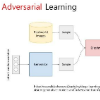The prevalence of mobility impairments due to conditions such as spinal cord injuries, strokes, and degenerative diseases is on the rise globally. Lower-limb exoskeletons have been increasingly recognized as a viable solution for enhancing mobility and rehabilitation for individuals with such impairments. However, existing exoskeleton control systems often suffer from limitations such as latency, lack of adaptability, and computational inefficiency. To address these challenges, this paper introduces a novel online adversarial learning architecture integrated with edge computing for high-level lower-limb exoskeleton control. In the proposed architecture, sensor data from the user is processed in real-time through edge computing nodes, which then interact with an online adversarial learning model. This model adapts to the user's specific needs and controls the exoskeleton with minimal latency. Experimental evaluations demonstrate significant improvements in control accuracy and adaptability, as well as enhanced quality-of-service (QoS) metrics. These findings indicate that the integration of online adversarial learning with edge computing offers a robust and efficient approach for the next generation of lower-limb exoskeleton control systems.
翻译:暂无翻译



